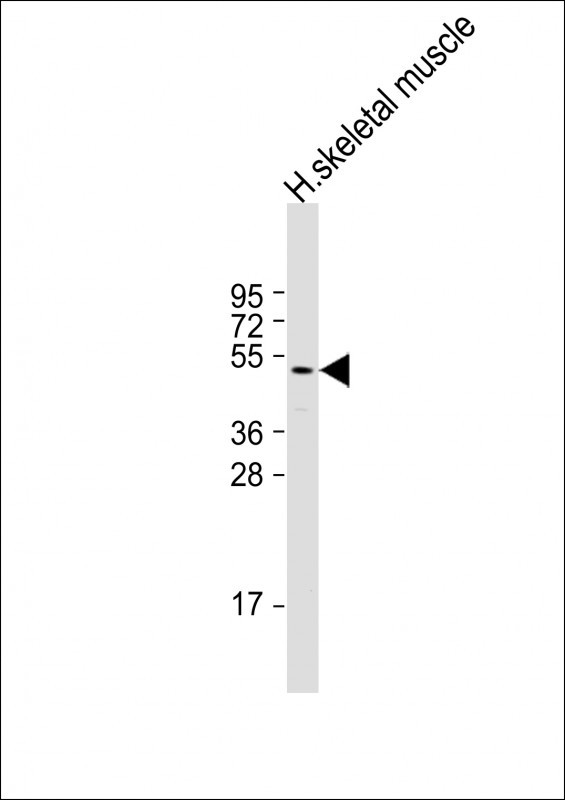
| WB | 1/2000 | Human,Mouse,Rat |
| IF | 咨询技术 | Human,Mouse,Rat |
| IHC | 咨询技术 | Human,Mouse,Rat |
| ICC | 技术咨询 | Human,Mouse,Rat |
| FCM | 咨询技术 | Human,Mouse,Rat |
| Elisa | 咨询技术 | Human,Mouse,Rat |
| Aliases | Palmitoyltransferase ZDHHC9, Zinc finger DHHC domain-containing protein 9, DHHC-9, DHHC9, Zinc finger protein 379, Zinc finger protein 380, ZDHHC9, CXorf11, ZDHHC10, ZNF379, ZNF380 |
| Entrez GeneID | 51114 |
| WB Predicted band size | 40.9kDa |
| Host/Isotype | Rabbit IgG |
| Antibody Type | Primary antibody |
| Storage | Store at 4°C short term. Aliquot and store at -20°C long term. Avoid freeze/thaw cycles. |
| Species Reactivity | Human, Mouse |
| Immunogen | This ZDHHC9 antibody is generated from rabbits immunized with a KLH conjugated synthetic peptide between 335-364 amino acids from the C-terminal region of human ZDHHC9. |
| Formulation | Purified antibody in PBS with 0.05% sodium azide. |
+ +
以下是关于ZDHHC9抗体的3篇参考文献的简要信息:
1. **文献名称**:*"ZDHHC9-mediated palmitoylation of SNAP25 regulates synaptic exocytosis"*
**作者**:Ruskamo, S., et al.
**摘要**:该研究利用ZDHHC9抗体探究了ZDHHC9对突触蛋白SNAP25的棕榈酰化调控作用,发现其缺失会损害神经元突触小泡的释放功能。
2. **文献名称**:*"Mutations in ZDHHC9 cause X-linked intellectual disability and dysmorphic features"*
**作者**:Baker, K., et al.
**摘要**:通过ZDHHC9抗体检测患者细胞中的蛋白表达,发现该基因突变导致蛋白功能丧失,与X连锁智力障碍及发育异常表型相关。
3. **文献名称**:*"ZDHHC9 regulates breast cancer metastasis via palmitoylation of CD36"*
**作者**:Mitchell, D.A., et al.
**摘要**:研究使用ZDHHC9抗体验证其在乳腺癌细胞中的表达水平,发现其通过棕榈酰化CD36蛋白影响肿瘤细胞的脂质代谢和转移能力。
4. **文献名称**:*"ZDHHC9 deficiency alters neuronal morphology and reduces palmitoylation in a mouse model"*
**作者**:Lv, T., et al.
**摘要**:利用ZDHHC9抗体在小鼠脑组织中定位该蛋白,揭示其缺失导致神经元树突形态异常及棕榈酰化底物减少的分子机制。
以上文献均涉及ZDHHC9抗体的应用,涵盖神经功能、疾病机制及癌症研究领域。
ZDHHC9 antibody is a tool used to study the ZDHHC9 protein, a member of the DHHC (Asp-His-His-Cys) family of palmitoyltransferases. These enzymes catalyze protein palmitoylation, a post-translational modification critical for membrane anchoring, protein trafficking, and signaling. ZDHHC9 specifically interacts with the oligosaccharyltransferase complex and is implicated in N-terminal palmitoylation of specific substrates. Research links ZDHHC9 mutations to X-linked intellectual disability and autism spectrum disorders, often due to impaired enzyme activity affecting neuronal development. Additionally, dysregulated ZDHHC9 expression has been observed in certain cancers, suggesting roles in tumor progression.
The antibody enables detection and analysis of ZDHHC9 expression, localization, and function in cells or tissues. It is typically validated for applications like Western blotting, immunofluorescence, or immunohistochemistry. High-quality ZDHHC9 antibodies show specificity for their target, distinguishing it from other DHHC family members. Researchers use these antibodies to investigate ZDHHC9's involvement in neurological disorders, cancer biology, and metabolic pathways. Recent studies also explore its potential as a therapeutic target. Proper validation using knockout controls or peptide-blocking assays is essential to confirm antibody reliability, as cross-reactivity remains a concern given the conserved DHHC domain across family members.
×